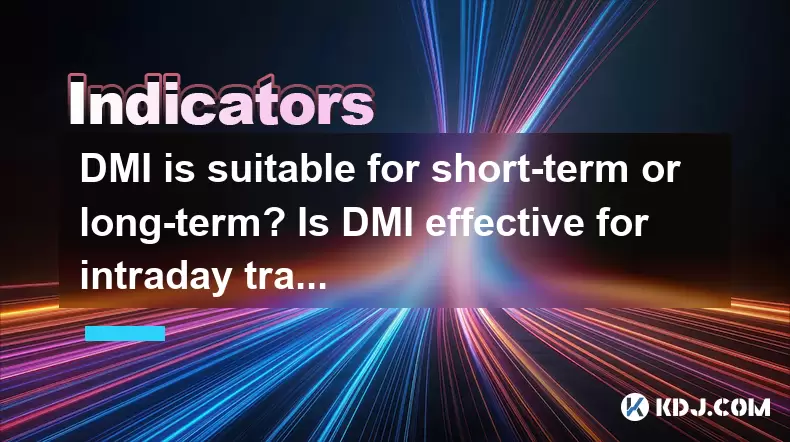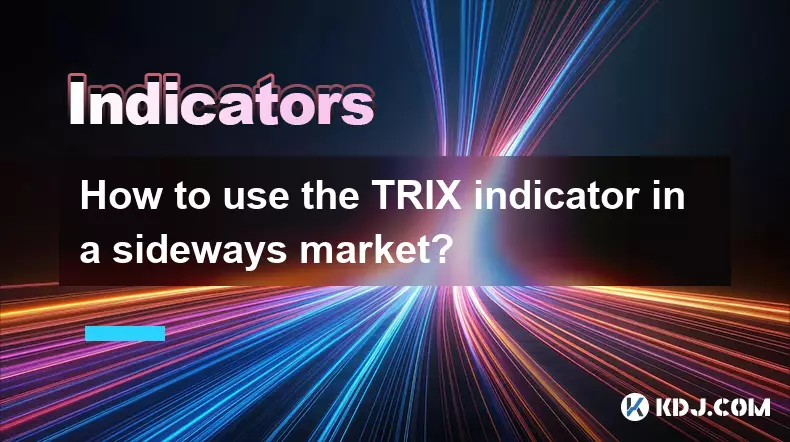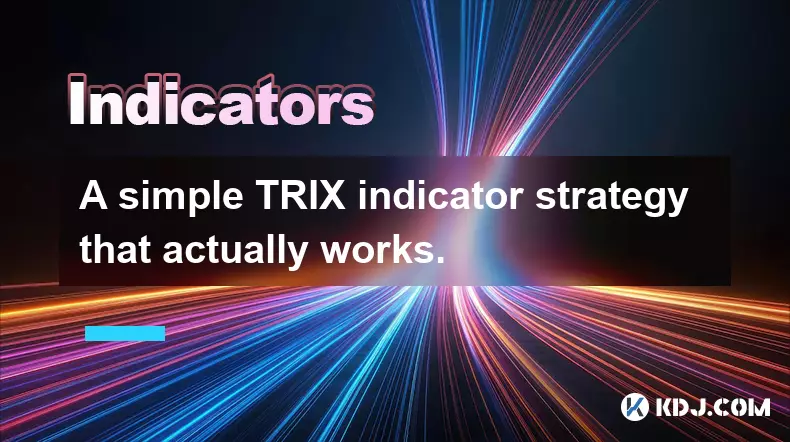-
 bitcoin
bitcoin $106680.127705 USD
0.67% -
 ethereum
ethereum $3615.722480 USD
-0.65% -
 tether
tether $0.999925 USD
-0.04% -
 xrp
xrp $2.550072 USD
5.91% -
 bnb
bnb $1002.572269 USD
-0.90% -
 solana
solana $168.746669 USD
1.08% -
 usd-coin
usd-coin $0.999832 USD
-0.03% -
 tron
tron $0.297244 USD
1.97% -
 dogecoin
dogecoin $0.182965 USD
0.71% -
 cardano
cardano $0.600432 USD
2.56% -
 hyperliquid
hyperliquid $41.439691 USD
-1.57% -
 chainlink
chainlink $16.548399 USD
2.40% -
 bitcoin-cash
bitcoin-cash $524.993680 USD
3.45% -
 stellar
stellar $0.302259 USD
4.10% -
 zcash
zcash $539.994871 USD
-16.31%
DMI is suitable for short-term or long-term? Is DMI effective for intraday trading?
DMI is effective for short-term, long-term, and intraday crypto trading, but requires adjustments and combination with other indicators for best results.
May 23, 2025 at 02:29 pm

The Directional Movement Index (DMI) is a widely used technical indicator in the cryptocurrency trading world, designed to help traders identify the direction of a market trend and its strength. A common question among traders is whether DMI is better suited for short-term or long-term trading, and if it can be effectively used for intraday trading. This article will delve into these questions, providing a detailed analysis of DMI's application across different trading timeframes.
Understanding the DMI Indicator
Before diving into the suitability of DMI for various trading horizons, it's important to understand what the DMI is and how it functions. The DMI consists of three lines: the Positive Directional Indicator (+DI), the Negative Directional Indicator (-DI), and the Average Directional Index (ADX). The +DI and -DI lines help identify the direction of the trend, while the ADX line measures the strength of the trend.
+DI (Positive Directional Indicator) is used to gauge the upward movement in the market. It is calculated by comparing the current high with the previous high.
-DI (Negative Directional Indicator) measures the downward movement in the market. It is calculated by comparing the current low with the previous low.
ADX (Average Directional Index) indicates the strength of the trend, regardless of its direction. It is calculated based on the difference between +DI and -DI, smoothed over time.
DMI for Short-Term Trading
Short-term trading, often involving holding positions for a few days to a few weeks, can benefit significantly from the use of DMI. The indicator's ability to identify the direction and strength of a trend makes it a valuable tool for traders looking to capitalize on short-term market movements.
In short-term trading, the key is to use DMI in conjunction with other indicators to confirm signals. For instance, a trader might look for a crossover of the +DI and -DI lines to identify potential entry and exit points. When the +DI line crosses above the -DI line, it suggests a potential bullish trend, and vice versa for a bearish trend. Additionally, the ADX line can help traders assess whether the trend is strong enough to warrant a trade.
DMI for Long-Term Trading
For long-term trading, where positions are held for months or even years, DMI can still be useful, though its application might differ slightly from short-term trading. Long-term traders often focus more on the overall trend direction and strength, rather than short-term fluctuations.
In long-term trading, the ADX line becomes particularly important. A high ADX value indicates a strong trend, which is crucial for long-term traders to confirm before entering a position. For example, if the ADX is above 25, it typically indicates a strong trend, suggesting that it might be a good time to enter a long-term position in the direction of the trend.
DMI for Intraday Trading
Intraday trading involves buying and selling assets within the same trading day, making it one of the most challenging forms of trading. The question of whether DMI is effective for intraday trading is crucial for many traders.
DMI can be used effectively for intraday trading, but it requires a more nuanced approach. Intraday traders need to adjust the settings of the DMI to shorter timeframes to capture the rapid movements of the market. For instance, instead of using the standard 14-period setting, intraday traders might use a 5 or 10-period setting to make the indicator more responsive to short-term price movements.
Additionally, intraday traders should combine DMI with other indicators, such as moving averages or the Relative Strength Index (RSI), to confirm signals and reduce the likelihood of false positives. For example, a crossover of the +DI and -DI lines, coupled with a moving average crossover, can provide a more reliable signal for intraday trading.
Practical Application of DMI in Trading
To illustrate how DMI can be applied in trading, let's walk through a practical example of using DMI for both short-term and intraday trading.
Short-Term Trading Example
- Identify the Trend: Look for a crossover of the +DI and -DI lines. If the +DI crosses above the -DI, it indicates a potential bullish trend.
- Confirm the Trend Strength: Check the ADX line. If the ADX is above 25, it suggests a strong trend, which is a good signal to enter a trade.
- Enter the Trade: Buy the cryptocurrency when the +DI is above the -DI and the ADX is strong.
- Set Stop-Loss and Take-Profit Levels: Use technical analysis to set appropriate stop-loss and take-profit levels to manage risk.
- Monitor the Trade: Keep an eye on the DMI lines and ADX to decide when to exit the trade. If the -DI crosses above the +DI, it might be time to exit the trade.
Intraday Trading Example
- Adjust DMI Settings: Set the DMI to a shorter timeframe, such as a 5-period setting, to make it more responsive to intraday movements.
- Look for Crossovers: Monitor the +DI and -DI lines for crossovers. A +DI crossover above the -DI indicates a potential short-term bullish move.
- Confirm with Other Indicators: Use a moving average or RSI to confirm the signal. For instance, if the price is above a short-term moving average and the RSI is not overbought, it might be a good entry point.
- Enter the Trade: Buy the cryptocurrency based on the confirmed signal.
- Set Tight Stop-Loss and Take-Profit Levels: Given the fast-paced nature of intraday trading, set tight stop-loss and take-profit levels to manage risk effectively.
- Exit the Trade: Exit the trade based on the DMI signals or other confirming indicators. If the -DI crosses above the +DI, it might be time to sell.
DMI in Different Market Conditions
The effectiveness of DMI can vary depending on market conditions. In trending markets, DMI can be highly effective as it excels at identifying and confirming trends. Traders can use the ADX to gauge the strength of the trend and make informed decisions.
In sideways or range-bound markets, DMI might produce more false signals, as the lack of a clear trend can cause the +DI and -DI lines to cross frequently without a sustained move in either direction. In such cases, combining DMI with other indicators, such as Bollinger Bands or the RSI, can help filter out false signals.
FAQs
Q: Can DMI be used as a standalone indicator?A: While DMI can provide valuable insights into trend direction and strength, it is generally more effective when used in conjunction with other technical indicators. Combining DMI with tools like moving averages, RSI, or Bollinger Bands can help confirm signals and reduce the risk of false positives.
Q: How often should I adjust the DMI settings for different trading timeframes?A: The frequency of adjusting DMI settings depends on the trading timeframe and market conditions. For short-term trading, adjusting the settings every few weeks or when market conditions change significantly can be beneficial. For intraday trading, more frequent adjustments might be necessary, such as daily or even hourly, to keep the indicator responsive to rapid market movements.
Q: Is DMI more effective in certain cryptocurrency markets?A: DMI can be effective across various cryptocurrency markets, but its performance may vary depending on the liquidity and volatility of the specific market. In highly liquid and volatile markets, DMI can be particularly useful for identifying and capitalizing on trends. In less liquid markets, the indicator might produce more false signals due to the increased noise in price movements.
Q: Can DMI help in managing risk in trading?A: Yes, DMI can be a valuable tool for risk management. By providing insights into trend direction and strength, traders can use DMI to set appropriate stop-loss and take-profit levels. For example, entering a trade when the ADX indicates a strong trend can increase the likelihood of a successful trade, while exiting a trade when the trend weakens can help minimize losses.
Disclaimer:info@kdj.com
The information provided is not trading advice. kdj.com does not assume any responsibility for any investments made based on the information provided in this article. Cryptocurrencies are highly volatile and it is highly recommended that you invest with caution after thorough research!
If you believe that the content used on this website infringes your copyright, please contact us immediately (info@kdj.com) and we will delete it promptly.
- Meme Coins, Degen Alpha, and Market Updates: Navigating the Crypto Landscape
- 2025-11-11 19:00:02
- XRP and Dogecoin: Millionaire-Maker Showdown or Just a Meme?
- 2025-11-11 18:50:01
- Decoding Crypto Trends: Square's Bitcoin Leap, McRib's Market Magic, and the Altcoin Surge
- 2025-11-11 19:50:01
- CryptoQuant: ETF Buying on Thin Ice? Sellers Primed to Dominate
- 2025-11-11 19:10:02
- Altcoin ETF Mania: XRP ETF Launch Date Buzz and Beyond!
- 2025-11-11 19:50:01
- Uniswap's UNI Surges: Burn Mechanism Ignites Price Rally!
- 2025-11-11 19:10:02
Related knowledge

What's the best way to learn the TRIX indicator?
Nov 10,2025 at 12:39pm
Understanding the Basics of the TRIX Indicator1. The TRIX (Triple Exponential Average) indicator is a momentum oscillator designed to filter out short...

How do professional traders use the TRIX indicator?
Nov 06,2025 at 04:40pm
Understanding the TRIX Indicator in Crypto TradingThe TRIX (Triple Exponential Average) indicator is a momentum oscillator used by professional trader...

Can I use the TRIX indicator on my mobile trading app?
Nov 07,2025 at 07:40pm
The TRIX indicator, a momentum oscillator designed to filter out short-term fluctuations and highlight long-term trends, has become increasingly popul...

How to use the TRIX indicator in a sideways market?
Nov 10,2025 at 03:00pm
Bitcoin’s Role in Decentralized Finance Evolution1. Bitcoin remains the cornerstone of decentralized finance, serving as both a store of value and a b...

How to code a simple TRIX indicator script in Pine Script?
Nov 07,2025 at 06:20am
How to Code a Simple TRIX Indicator in Pine Script The TRIX (Triple Exponential Moving Average) indicator is widely used in cryptocurrency trading to ...

A simple TRIX indicator strategy that actually works.
Nov 08,2025 at 05:39pm
Understanding the TRIX Indicator in Crypto Trading1. The TRIX (Triple Exponential Average) indicator is a momentum oscillator designed to filter out s...

What's the best way to learn the TRIX indicator?
Nov 10,2025 at 12:39pm
Understanding the Basics of the TRIX Indicator1. The TRIX (Triple Exponential Average) indicator is a momentum oscillator designed to filter out short...

How do professional traders use the TRIX indicator?
Nov 06,2025 at 04:40pm
Understanding the TRIX Indicator in Crypto TradingThe TRIX (Triple Exponential Average) indicator is a momentum oscillator used by professional trader...

Can I use the TRIX indicator on my mobile trading app?
Nov 07,2025 at 07:40pm
The TRIX indicator, a momentum oscillator designed to filter out short-term fluctuations and highlight long-term trends, has become increasingly popul...

How to use the TRIX indicator in a sideways market?
Nov 10,2025 at 03:00pm
Bitcoin’s Role in Decentralized Finance Evolution1. Bitcoin remains the cornerstone of decentralized finance, serving as both a store of value and a b...

How to code a simple TRIX indicator script in Pine Script?
Nov 07,2025 at 06:20am
How to Code a Simple TRIX Indicator in Pine Script The TRIX (Triple Exponential Moving Average) indicator is widely used in cryptocurrency trading to ...

A simple TRIX indicator strategy that actually works.
Nov 08,2025 at 05:39pm
Understanding the TRIX Indicator in Crypto Trading1. The TRIX (Triple Exponential Average) indicator is a momentum oscillator designed to filter out s...
See all articles









































































